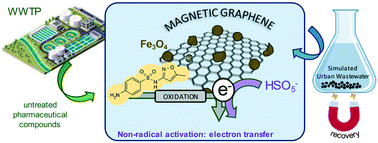Activation of inorganic peroxides with magnetic graphene for the removal of antibiotics from wastewater†
Abstract
Magnetic graphene catalysts were prepared for the removal of antibiotics (sulfamethoxazole, norfloxacin, tetracycline and flumequine) from water. Different proportions of magnetite–graphene from 1 : 0 to 0 : 1 were considered to study the catalytic activation of inorganic peroxides, i.e. peroxymonosulfate (PMS), peroxydisulfate and hydrogen peroxide. The presence of graphene was mainly responsible for the activation, which was most effective in the presence of PMS. A ratio of 20% of magnetite in the solid was enough to achieve complete degradation of antibiotics with high recovery by application of a magnetic field. The performance of the catalyst was further evaluated in a simulated urban wastewater, studying the main parameters affecting the process and the stability in sequential reuses. The non-radical mechanism during the catalytic activation of PMS was hypothesized from kinetic scavenging probes tests. The electron transfer was suggested as the mechanism of the reaction from electron paramagnetic resonance analysis in the presence of D2O. The prepared magnetic catalyst showed high catalytic activity and stability to remove antibiotics from water.



 Please wait while we load your content...
Please wait while we load your content...